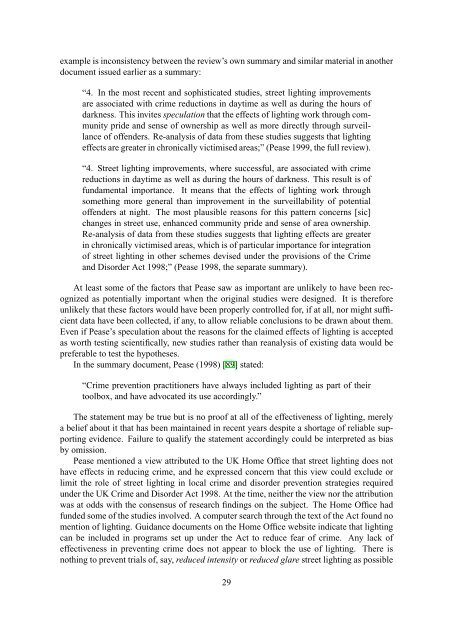outdoor lighting and crime, part 1 - Astronomical Society of Victoria
outdoor lighting and crime, part 1 - Astronomical Society of Victoria
outdoor lighting and crime, part 1 - Astronomical Society of Victoria
Create successful ePaper yourself
Turn your PDF publications into a flip-book with our unique Google optimized e-Paper software.
example is inconsistency between the review’s own summary <strong>and</strong> similar material in another<br />
document issued earlier as a summary:<br />
“4. In the most recent <strong>and</strong> sophisticated studies, street <strong>lighting</strong> improvements<br />
are associated with <strong>crime</strong> reductions in daytime as well as during the hours <strong>of</strong><br />
darkness. This invites speculation that the effects <strong>of</strong> <strong>lighting</strong> work through community<br />
pride <strong>and</strong> sense <strong>of</strong> ownership as well as more directly through surveillance<br />
<strong>of</strong> <strong>of</strong>fenders. Re-analysis <strong>of</strong> data from these studies suggests that <strong>lighting</strong><br />
effects are greater in chronically victimised areas;” (Pease 1999, the full review).<br />
“4. Street <strong>lighting</strong> improvements, where successful, are associated with <strong>crime</strong><br />
reductions in daytime as well as during the hours <strong>of</strong> darkness. This result is <strong>of</strong><br />
fundamental importance. It means that the effects <strong>of</strong> <strong>lighting</strong> work through<br />
something more general than improvement in the surveillability <strong>of</strong> potential<br />
<strong>of</strong>fenders at night. The most plausible reasons for this pattern concerns [sic]<br />
changes in street use, enhanced community pride <strong>and</strong> sense <strong>of</strong> area ownership.<br />
Re-analysis <strong>of</strong> data from these studies suggests that <strong>lighting</strong> effects are greater<br />
in chronically victimised areas, which is <strong>of</strong> <strong>part</strong>icular importance for integration<br />
<strong>of</strong> street <strong>lighting</strong> in other schemes devised under the provisions <strong>of</strong> the Crime<br />
<strong>and</strong> Disorder Act 1998;” (Pease 1998, the separate summary).<br />
At least some <strong>of</strong> the factors that Pease saw as important are unlikely to have been recognized<br />
as potentially important when the original studies were designed. It is therefore<br />
unlikely that these factors would have been properly controlled for, if at all, nor might sufficient<br />
data have been collected, if any, to allow reliable conclusions to be drawn about them.<br />
Even if Pease’s speculation about the reasons for the claimed effects <strong>of</strong> <strong>lighting</strong> is accepted<br />
as worth testing scientifically, new studies rather than reanalysis <strong>of</strong> existing data would be<br />
preferable to test the hypotheses.<br />
In the summary document, Pease (1998) [89] stated:<br />
“Crime prevention practitioners have always included <strong>lighting</strong> as <strong>part</strong> <strong>of</strong> their<br />
toolbox, <strong>and</strong> have advocated its use accordingly.”<br />
The statement may be true but is no pro<strong>of</strong> at all <strong>of</strong> the effectiveness <strong>of</strong> <strong>lighting</strong>, merely<br />
a belief about it that has been maintained in recent years despite a shortage <strong>of</strong> reliable supporting<br />
evidence. Failure to qualify the statement accordingly could be interpreted as bias<br />
by omission.<br />
Pease mentioned a view attributed to the UK Home Office that street <strong>lighting</strong> does not<br />
have effects in reducing <strong>crime</strong>, <strong>and</strong> he expressed concern that this view could exclude or<br />
limit the role <strong>of</strong> street <strong>lighting</strong> in local <strong>crime</strong> <strong>and</strong> disorder prevention strategies required<br />
under the UK Crime <strong>and</strong> Disorder Act 1998. At the time, neither the view nor the attribution<br />
was at odds with the consensus <strong>of</strong> research findings on the subject. The Home Office had<br />
funded some <strong>of</strong> the studies involved. A computer search through the text <strong>of</strong> the Act found no<br />
mention <strong>of</strong> <strong>lighting</strong>. Guidance documents on the Home Office website indicate that <strong>lighting</strong><br />
can be included in programs set up under the Act to reduce fear <strong>of</strong> <strong>crime</strong>. Any lack <strong>of</strong><br />
effectiveness in preventing <strong>crime</strong> does not appear to block the use <strong>of</strong> <strong>lighting</strong>. There is<br />
nothing to prevent trials <strong>of</strong>, say, reduced intensity or reduced glare street <strong>lighting</strong> as possible<br />
29
















